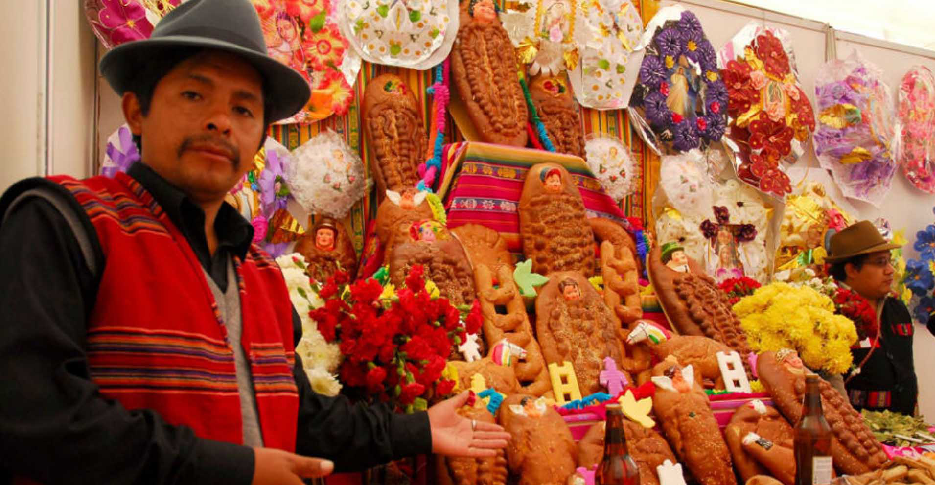
The Day of the Dead (Día de los Muertos) is a deeply rooted tradition in Peru, celebrated annually on November 2nd. This event is a fusion of indigenous customs and Catholic influences, creating a unique and heartfelt homage to departed loved ones. Each region of Peru embraces this commemoration in distinct ways, blending spirituality, music, food, and festivity. From the highlands of Cusco to the coastal city of Lima, the Day of the Dead in Peru is a vibrant reflection of the country’s rich cultural heritage.
Traditional Celebrations Across Peru
1. Andean Highlands: Spiritual and Ancestral Rituals
In the Andean regions, including Cusco, Puno, and Ayacucho, families visit cemeteries to clean and decorate the graves of their loved ones. They bring flowers, candles, and personal offerings, creating a serene and spiritual atmosphere. An essential part of these ceremonies is the preparation of “tantawawas,” intricately designed sweet breads shaped like dolls or children, symbolizing the continuity of life.
Communities gather to share stories, recite prayers, and honor the spirits of their ancestors. Some families also place favorite foods, drinks, and small personal belongings on graves, believing that the spirits return to enjoy these offerings. Music and traditional dances often accompany these gatherings, reinforcing the communal bond and ancestral respect that define Andean culture.
2. Lima: A Festive and Musical Homage
Lima, the capital city, embraces the Day of the Dead with a more vibrant and celebratory approach. Cemeteries become lively spaces filled with families playing music, sharing food, and reminiscing about their departed loved ones.
A unique aspect of Lima’s celebrations is its connection with the Day of Creole Song (Día de la Canción Criolla), which is observed on October 31st. This day celebrates Peru’s distinctive Creole music, featuring guitar and cajón (a traditional wooden percussion instrument). The overlap of these two events creates an extended period of festivities, where people enjoy traditional songs, dances, and feasts in honor of their ancestors.
3. Northern Peru: Sweet Offerings and Regional Delicacies
In the northern coastal regions, such as Piura and Lambayeque, food plays a central role in the celebration. Families prepare and offer “angelitos,” sweet treats dedicated to children, symbolizing innocence and remembrance. Another regional specialty is “roscas de muerto,” a circular bread accompanied by honey, which represents the eternal cycle of life and death.
Meanwhile, in Lima and other regions, the “Turrón de Doña Pepa” is an iconic treat associated with this time of year. Made with anise-flavored dough, butter, and honey, this colorful and aromatic dessert is a must-have during the celebrations.
The Role of Food in Day of the Dead Traditions
Food is an integral part of the Day of the Dead in Peru, serving as both an offering to the departed and a way for families to bond during the commemorations. Some of the most popular dishes include:
- Tantawawas – Sweet breads shaped like children, often decorated with colorful toppings.
- Turrón de Doña Pepa – A layered anise and honey pastry topped with vibrant sprinkles.
- Lechón al Horno – A slow-roasted suckling pig dish, often enjoyed as part of large family gatherings.
- Tamales – Corn-based dough filled with meat or cheese, wrapped in banana leaves and steamed.
- Chicha Morada – A traditional Peruvian drink made from purple corn, infused with cinnamon and cloves.
These culinary traditions not only preserve the memory of loved ones but also reinforce Peru’s cultural identity through generational recipes and flavors.
Symbolism and Cultural Significance
The Day of the Dead in Peru is more than just a day of remembrance; it is a vibrant expression of Andean cosmovision and Catholic influences, interwoven into a singular, meaningful tradition. Some key symbolic elements include:
- Altars (Ofrendas): Decorated with photographs, flowers, candles, and favorite foods of the deceased.
- Marigolds (Cempasúchil): Known as the “flower of the dead,” they guide spirits back to the world of the living.
- Incense (Palo Santo): Used to purify spaces and welcome ancestral spirits.
- Skulls (Calaveras): Representing the cycle of life and death, these can be found as edible sugar skulls or artistic decorations.
Peruvians believe that on this day, the souls of the departed return to visit their loved ones, and the offerings prepared help them feel welcomed and remembered.
Preserving Tradition in Modern Times
As globalization influences traditions worldwide, many Peruvians are actively working to preserve the authenticity of the Day of the Dead. Schools and cultural organizations encourage younger generations to learn about these customs, while local businesses and communities continue to support the production of traditional foods and decorations.
Additionally, tourism plays a growing role in maintaining these traditions. Visitors seeking an immersive cultural experience can participate in guided tours, attend cemetery festivities, and enjoy regional delicacies, ensuring that these rich traditions continue to thrive.
Final Thoughts
The Day of the Dead in Peru is a poignant celebration that merges spirituality, music, and gastronomy to honor departed loved ones. From the solemn rituals in the highlands to the lively gatherings in Lima, each region showcases its unique customs while collectively preserving the essence of this cherished tradition. As Peruvians continue to pass down these practices, the Day of the Dead remains a testament to the country’s deep respect for ancestry, community, and cultural heritage.